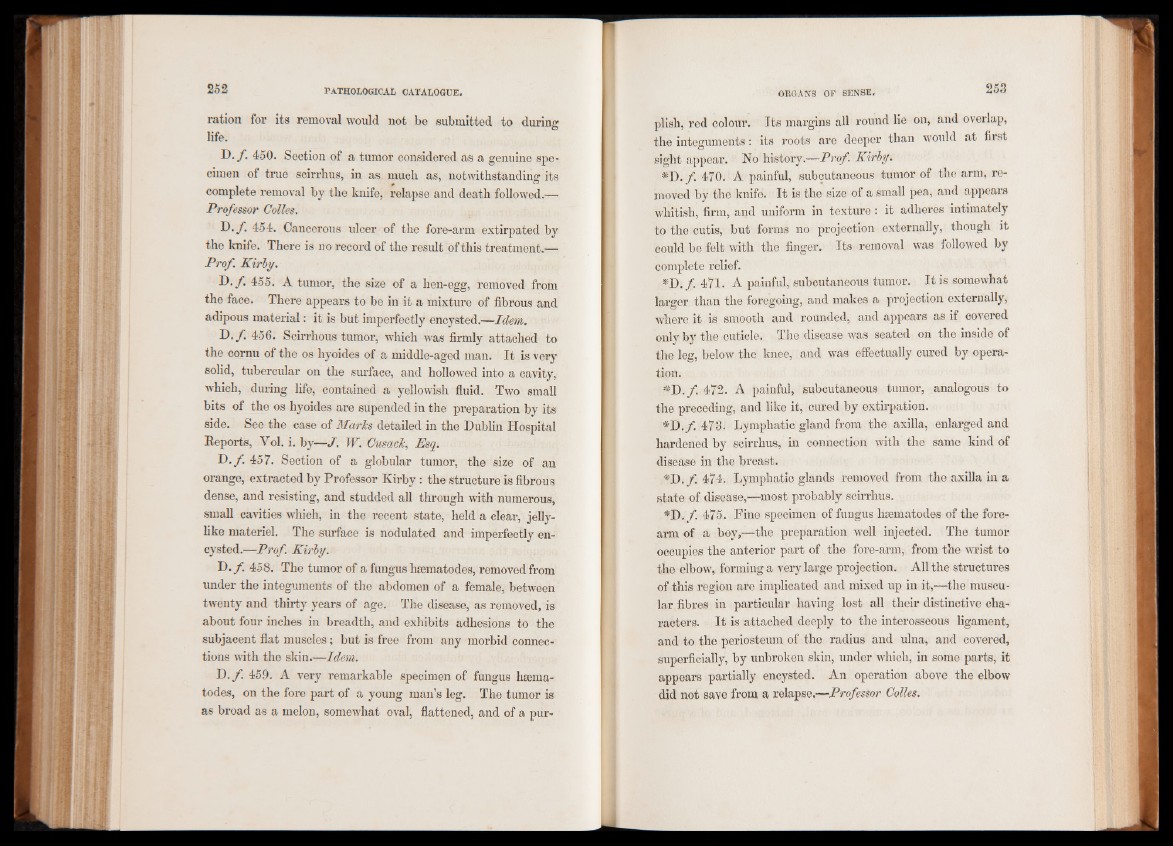
ration for its removal would not be submitted to during
life.
D. ƒ. 450. Section of a tumor considered as a genuine specimen
of true scirrhus, in as much as, notwithstanding its
complete removal by the knife, relapse and death followed.—
Professor Colles.
D. ƒ. 454. Cancerous ulcer of the fore-arm extirpated by
the knife. There is no record of the result of this treatment.—
Prof. Kirby.
D. ƒ. 455. A tumor, the size of a hen-egg, removed from
the face. There appears to be in it a mixture of fibrous and
adipous material: it is but imperfectly encysted.—Idem.
D. ƒ. 456. Scirrhous tumor, which was firmly attached to
the cornu of the os hyoides of a middle-aged man. It is very
solid, tubercular on the surface, and hollowed into a cavity,
which, during life, contained a yellowish fluid. Two small
bits of the os hyoides are supended in the preparation by its
side. See the case of Maries detailed in the Dublin Hospital
Reports, Vol. i. by—J. W. Cusack, Esq.
D. ƒ. 457. Section of a globular tumor, the size of an
orange, extracted by Professor Kirby : the structure is fibrous
dense, and resisting, and studded all through with numerous,
small cavities which, in the recent state, held a clear, jelly-
like materiel. The surface is nodulated and imperfectly encysted.—
Prof. Kirby.
D. ƒ. 458. The tumor of a fungus hsematodes, removed from
under the integuments of the abdomen of a female, between
twenty and thirty years of age. The disease, as removed, is
about four inches in breadth, and exhibits adhesions to the
subjacent flat muscles; but is free from any morbid connections
with the skin.—Idem.
D./. 459. A very remarkable specimen of fungus hsematodes,
on the fore part of a young man’s leg. The tumor is
as broad as a melon, somewhat oval, flattened, and of a purplish,
red colour. Its margins all round lie on, and overlap,
the integuments: its roots are deeper than would at first
sight appear. No history.—Prof. Kirby.
*D. ƒ. 470. A painful, subcutaneous tumor of the arm, removed
by the knife. It is the size of a small pea, and appears
whitish, firm, and uniform in texture: it adheres intimately
to the cutis, but forms no projection externally, though it
could be felt with the finger. Its removal was followed by
complete relief.
*D./. 471. A painful, subcutaneous tumor. It is somewhat
larger than the foregoing, and makes a projection externally,
where it is smooth and rounded, and appears as if covered
only by the cuticle. The disease was seated on the inside of
the leg, below the knee, and was effectually cured by operation.
*D. ƒ. 472. A painful, subcutaneous tumor, analogous to
the preceding, and like it, cured by extirpation.
#D f. 473. Lymphatic gland from the axilla, enlarged and
hardened by scirrhus, in connection with the same kind of
disease in the breast.
*D. ƒ. 474. Lymphatic glands removed from the axilla in a
state of disease,—most probably scirrhus.
*D. f. 475. Fine specimen of fungus hsematodes of the forearm
of a boy,—the preparation well injected. The tumor
occupies the anterior part of the fore-arm, from the wrist to
the elbow, forming a very large projection. All the structures
of this region are implicated and mixed up in it,—the muscular
fibres in particular having lost all their distinctive characters.
It is attached deeply to the interosseous ligament,
and to the periosteum of the radius and ulna, and covered,
superficially, by unbroken skin, under which, in some parts, it
appears partially encysted. An operation above the elbow
did not save from a relapse.—Professor Colles.